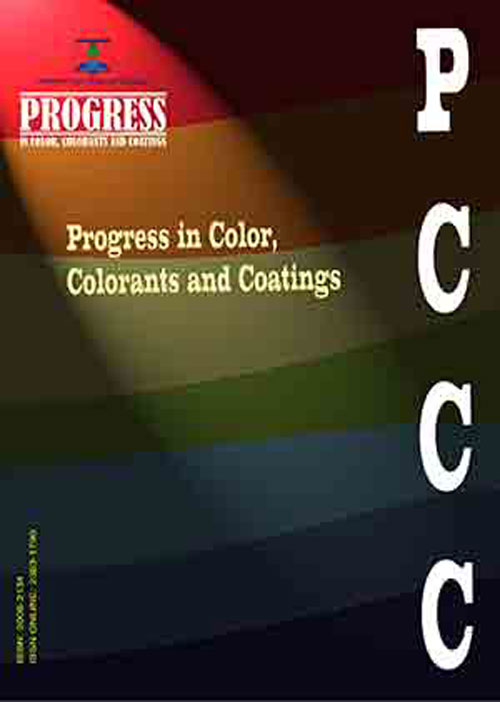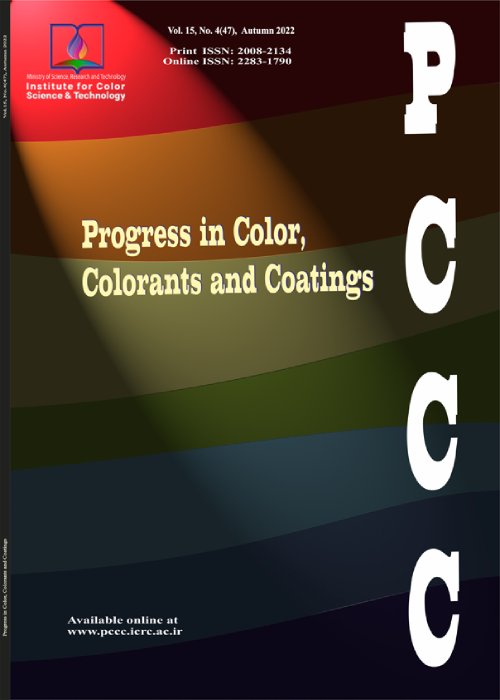فهرست مطالب

Progress in Color, Colorants and Coatings
Volume:14 Issue: 3, Summer 2021
- تاریخ انتشار: 1399/09/12
- تعداد عناوین: 7
-
-
Pages 149-160
Nickel is an essential engineering material and electrodeposited Ni has been widely used in many fields to improve surface finishing, corrosion resistance and wear properties. The kinetics of electrochemical deposition of nickel from chloride baths in the presence and absence of saccharin on the copper substrate was investigated by applying cyclic voltammetry and chronoamperometry measurements. Our results showed that the kinetics of electrochemical deposition of nickel on the copper substrate was under diffusion control. In addition, in the presence of saccharin, the cathodic current peak decreased and the cathodic potential shifted to the more negative potentials. Nucleation and growth mechanisms also changed from instantaneous to progressive. Characteristics of nanocrystalline nickel coatings were studied by X-ray diffractometry (XRD) and field emission scanning electron microscopy (FESEM). XRD patterns showed the decrease of grain size in the presence of saccharin. FESEM images showed that the microstructure is modified and the morphology changes from cauliflower like to spherical in the presence of saccharin.
Keywords: Nanocrystalline nickel coatings, Voltammetry, Chronoamperometry, Electrodeposition kinetics -
Pages 161-178
This work aims to study the photodegradation of Direct Blue 199 dye. The investigation was performed using titanium dioxide-based films immobilized on a polymethyl methacrylate (PMMA) polymer, by a promising low coast technique. The characterization of the films by X-ray diffractometry, fourier transform infrared spectroscopy, scanning electron microscopy, UV-Visible transmittance, and fluorescence spectroscopy revealed the deposition of 13.76% by mass of TiO2 with excellent adhesion to the polymer surface. However, the evaluation of the influence of three parameters (pH, initial TiO2 concentration, H2O2 concentration) on the efficiency of color removal in aqueous solution under UV irradiation on suspended semiconductors, have been performed using the response surface methodology based on experimental design. We therefore found the following optimum conditions: pH= 8, [TiO2] = 1369.29 mg.L-1, [H2O2] = 40 mmol.L-1 which led to a discoloration efficiency of 85 %. The results were then used to evaluate the performance of the prepared photocatalyst films, which showed a strong capacity to absorb the dye due to the appearance of pores relative to the preparation procedure, in addition to their catalytic effect. The kinetic of decolorization under optimum conditions was well fitted to the pseudo-first-order kinetic model.
Keywords: Photocatalysis, TiO2, Poly methyl methacrylate, Immobilization, Experiment design, Response surface, methodology -
Pages 179-187Anthocyanins are natural dye substances that provide attractive colors from red to blue. However, large quantities of Anthocyanins have been found in wastewater from soaked black beans, resulting in environmental pollution. The utilization of theses wastewaters would therefore be an effective way of reducing environmental pollution, and the water could be used to dye silk fabric, displaying a more sustainable use of resources. In this paper, the effects of pH, temperature and time for dyeing of silk fabric were investigated. It was found that the optimum dyeing conditions were pH 3 at 60 oC for 60 min to achieve the best colors and the most effective color fastness on silk. Moreover, Anthocyanins were the potential to reduce 80% gram-negative and gram-positive bacteria. These results improved our understanding of dyeing conditions using Anthocyanins in the wastewater from soaked black beans, which plays an important role in reducing pollution, reducing costs and improving the quality of the related dyeing fabric families.Keywords: Natural Dye, black beans, dyeing condition, Colorimetry, anti-bacteria
-
Pages 187-197This paper employs the electrochemical current noise (ECN) and electrochemical impedance spectroscopy (EIS) techniques to better evaluate the dissolved O2 concentration on the passive oxide film of AA6162 Al alloy. The ECN measurements were done on the asymmetrical electrodes with different sizes (2-200 mm2) after 5 min from immersion in each of 0.4% NaCl, 0.4% NaCl + 0.1% NaNO2 and 3.5% NaCl solutions containing different O2 concentrations (5-25 ppm). EIS measurements were used to calculate the thickness of the passive oxide film. In dilute NaCl solution, the dissolved oxygen played an active role with an increase in oxygen concentration up to 15 ppm, while with further increase of oxygen concentration it acted as a passive factor to decrease the corrosion activity. With increasing the concentration of oxygen from 5 to 25 ppm, in the concentrated NaCl solution, the oxide film thickness decreased as an evidence of the active role of the oxygen reduction reaction. The behavior of nitrite-containing NaCl solution was in accordance with the property of nitrite ion which assists the formation of the passive film according to the adsorption theory.Keywords: Electrochemical Current Noise, wavelet analysis, Oxygen Reduction Reaction (ORR), Asymmetrical Electrodes, Standard Deviation of Partial Signal (SDPS)
-
Pages 199-207Protection of the environment and keeping it from contaminants are critical issues. Polymers and oil-based plastics are unrenewable and entail a wide range of environmental pollution due to the long degradation. This study aims to synthesize bio-based coatings using natural substances, and evaluate their viscoelastic properties. Accordingly, first, UV-curable tri-functional castor oil-based waterborne urethane acrylate as a bio-friendly cross-linker was synthesized. Next, different weight percentages of the synthesized cross-linker were added to the UV-curable urethane acrylate resin, followed by UV radiation exposure to prepare, different flexible composite coatings. FT-IR spectroscopy was used to examine the progress of the cross-linker synthesis. The particle size analysis confirmed the stability and homogeneous distribution of the cross-linker particles in the emulsion. By DMTA analysis, viscoelastic characteristics of the films were studied. As a result, adding specific weight percentages of cross-linkers to the polymer matrix caused an increase in storage modulus and improvement of Tg of the coatings. The cross-link density of the film coatings was estimated from DMTA. The more weight percent of the cross-linker, the more is the cross-link density.Keywords: UV-curable urethane acrylate, cross-linker, bio-friendly, Viscoelastic Properties, Cross-link density
-
Pages 209-219Herein, polyvinyl butyral (PVB) films were synthesized using casting method and added to the PVB solution to make composites of PVB-nanoparticles were made via mixing 0.001 wt/wt % each time of each of the following metal nanoparticles (CuO, Cr2O3, NiO, TiO2 and Co3O4(NPs)) with PVB solution at room temperature. The PVB-NP composites as films were irradiated with UV light for prolonged period which demonstrated spectral, and weight-loss changes. Those changes were much more significant than that of the blank PVB films undergo under identical conditions. Incorporating surface morphology examination of the composites were conducted using scanning electron microscopy (SEM), energy x-ray dispersive (EDX) spectroscopy and atomic force microscope. Overall, findings revealed that PVB-(CuO, Cr2O3, NiO, TiO2 and Co3O4) NP composites showed a higher weight loss in compared to the PVB blank suggestive of higher photodegradation of the PVB-NP composites compared to the neat PVB film. A proposed photodegradation mechanism will be discussed.Keywords: UV exposure, poly(vinyl butyral), Nanoparticles, FESEM, irradiation
-
Pages 221-232This paper describes the changes in TiO2/SiO2 nanolayers properties induced by Ultraviolet- visible spectroscopy (UV) irradiation in terms of hydrophilicity/photocatalycity. The TiO2/SiO2 nano particles were synthesized by the sol-gel method and deposited on soda-lime glass by dip-coating. X-ray diffraction (XRD) of the TiO2 particles showed that the nano-particles were crystallized in anatase crystal structure with a crystallite size of ~12 nm. The morphology and surface roughness of TiO2 nanolayer were observed by scanning electron microscope (SEM) and atomic force microscopy (AFM) analysis. The surface roughness (Ra) for TiO2/Glass and TiO2/SiO2 was measured ~ 5 and 19 nm, respectively. The hardness of nanolayers on the glass was evaluated and scratch thickness for 1000 g sinker was measured ~150 nm. The self-cleaning properties were tested in dry condition (RH<15%) under UV irradiation by evaluating the oleic acid photodegradation and monitoring the hydrophilic properties of the surface with a contact angle measurement. The result showed that contact angle of the layer decreases from 77 to 42° after 25 h UV irradiation. Fourier-transform infrared spectroscopy- Attenuated total reflectance (FTIR-ATR) showed the elimination of C=O bonds of oleic acid on the surface after UV light irradiation. Water droplet contact angle measurement on TiO2 nano-layer exhibited a less hydrophilicity after UV irradiation and the contact angle changed from 15 to 40°, which may be due to the low atmospheric humidity. Adding SiO2 nanoparticles increases roughness of the nano-layer, from 5 to 19 nm, without a significant effect on the photodegradation rate of oleic acid.Keywords: Nano-layers, TiO2, SiO2, Photocatalysis, Hydrophilicity


